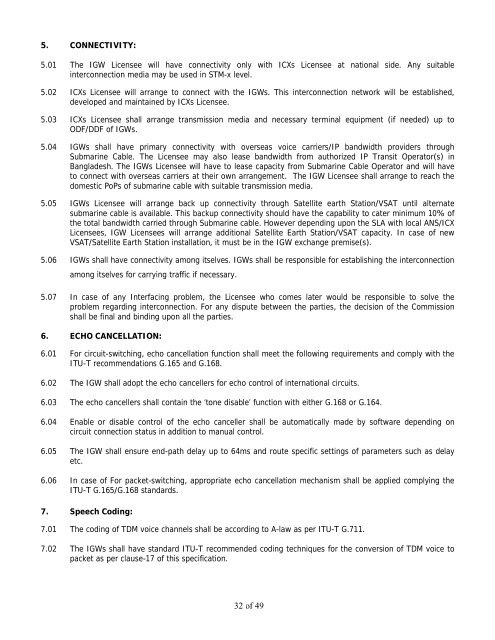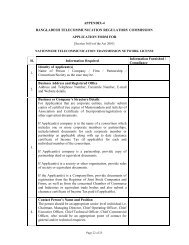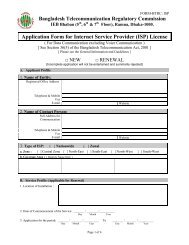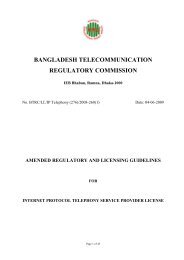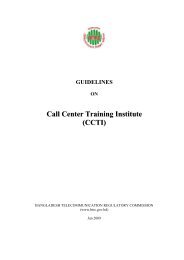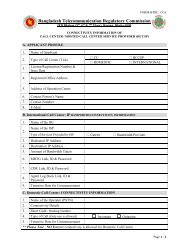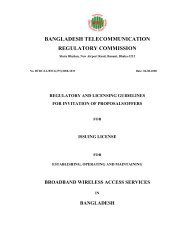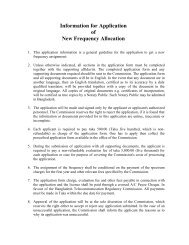BANGLADESH TELECOMMUNICATION REGULATORY ... - BTRC
BANGLADESH TELECOMMUNICATION REGULATORY ... - BTRC
BANGLADESH TELECOMMUNICATION REGULATORY ... - BTRC
You also want an ePaper? Increase the reach of your titles
YUMPU automatically turns print PDFs into web optimized ePapers that Google loves.
5. CONNECTIVITY:<br />
5.01 The IGW Licensee will have connectivity only with ICXs Licensee at national side. Any suitable<br />
interconnection media may be used in STM-x level.<br />
5.02 ICXs Licensee will arrange to connect with the IGWs. This interconnection network will be established,<br />
developed and maintained by ICXs Licensee.<br />
5.03 ICXs Licensee shall arrange transmission media and necessary terminal equipment (if needed) up to<br />
ODF/DDF of IGWs.<br />
5.04 IGWs shall have primary connectivity with overseas voice carriers/IP bandwidth providers through<br />
Submarine Cable. The Licensee may also lease bandwidth from authorized IP Transit Operator(s) in<br />
Bangladesh. The IGWs Licensee will have to lease capacity from Submarine Cable Operator and will have<br />
to connect with overseas carriers at their own arrangement. The IGW Licensee shall arrange to reach the<br />
domestic PoPs of submarine cable with suitable transmission media.<br />
5.05 IGWs Licensee will arrange back up connectivity through Satellite earth Station/VSAT until alternate<br />
submarine cable is available. This backup connectivity should have the capability to cater minimum 10% of<br />
the total bandwidth carried through Submarine cable. However depending upon the SLA with local ANS/ICX<br />
Licensees, IGW Licensees will arrange additional Satellite Earth Station/VSAT capacity. In case of new<br />
VSAT/Satellite Earth Station installation, it must be in the IGW exchange premise(s).<br />
5.06 IGWs shall have connectivity among itselves. IGWs shall be responsible for establishing the interconnection<br />
among itselves for carrying traffic if necessary.<br />
5.07 In case of any Interfacing problem, the Licensee who comes later would be responsible to solve the<br />
problem regarding interconnection. For any dispute between the parties, the decision of the Commission<br />
shall be final and binding upon all the parties.<br />
6. ECHO CANCELLATION:<br />
6.01 For circuit-switching, echo cancellation function shall meet the following requirements and comply with the<br />
ITU-T recommendations G.165 and G.168.<br />
6.02 The IGW shall adopt the echo cancellers for echo control of international circuits.<br />
6.03 The echo cancellers shall contain the ‘tone disable’ function with either G.168 or G.164.<br />
6.04 Enable or disable control of the echo canceller shall be automatically made by software depending on<br />
circuit connection status in addition to manual control.<br />
6.05 The IGW shall ensure end-path delay up to 64ms and route specific settings of parameters such as delay<br />
etc.<br />
6.06 In case of For packet-switching, appropriate echo cancellation mechanism shall be applied complying the<br />
ITU-T G.165/G.168 standards.<br />
7. Speech Coding:<br />
7.01 The coding of TDM voice channels shall be according to A-law as per ITU-T G.711.<br />
7.02 The IGWs shall have standard ITU-T recommended coding techniques for the conversion of TDM voice to<br />
packet as per clause-17 of this specification.<br />
32 of 49


